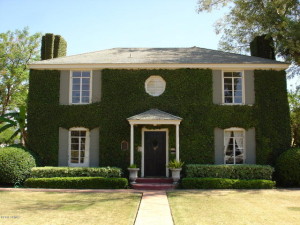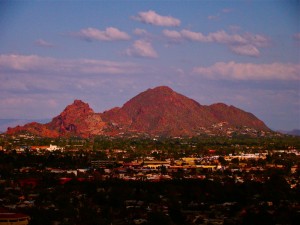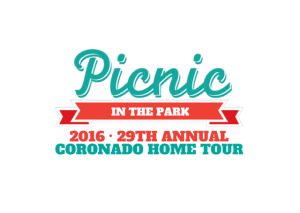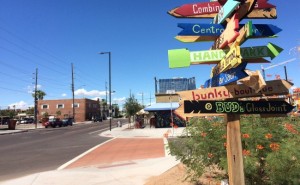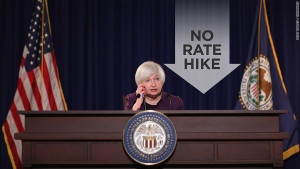ENCANTO-PALMCROFT HISTORIC DISTRICT
Encanto-Palmcroft Historic District runs from Seventh to 15th Avenues, and McDowell Road to the Encanto Park and Golf Course. It was recently ranked the wealthiest neighborhood in Phoenix.
Encanto-Palmcroft Homes For Sale
Encanto-Palmcroft Today
Encanto-Palmcroft is one of Phoenix’s priciest historic neighborhoods. Fortunately for those who like to fawn over early-20th-century Tudors and colonial call-backs, a walk through this European-style setup of abodes is not only open to the public, but also is absolutely free. Dating back to 1927, this (technically) West Phoenix pocket of 330 homes is situated along circular drives, winding roads, and the 222-acre Encanto Park. For newcomers and non-residents, this maze-like area is easy to get lost in, but you’ll hear little complaint from pedestrians who like to take in the suburban scenery. Here, well-manicured lawns and rose gardens highlight all styles of residence, from Pueblos to Ranch Revivals. Whether it’s a home tour, a film crew, or simply a nearby neighborhood dog walker, residents are sure to find their fair share of window shoppers in Palmcroft-Encanto.
Today, the Encanto-Palmcroft Historic District is still significant for its architectural diversity, picturesque homes and landscapes which are excellent representations of an early design philosophy which successfully integrated landscape and building. Architecturally, the district is one of the most important because it is an intact collection of the finest historic Phoenix homes in the city and one of the most desired historic districts in downtown Phoenix. Well appointed, designed by prominent early architects, built of high quality materials and distinguished by detailing and craftsmanship of a bygone era, the harmonious mix of diverse architectural styles in Encanto-Palmcroft create one of the most distinctive neighborhoods in Phoenix.
Architectural Styles and Square Footage: The Encanto-Palmcroft Historic District features a distinctive, wide variety of architecture like Monterey/Colonial Revival-styles, Spanish Colonials, Ranch Style, Tudor Revivals, Period Revivals, Spanish Revivals, Spanish Colonial/Ranch combos, Spanish Colonials, Mediterranean-style, Contemporary American International-style, English Cottage Revivals, two-story Spanish Colonial Revivals, two-story Monterey Colonial Revivals, Brick Regency Revival-styles, Single-Story Regency Revivals, Two-story Brick Mediterranean-styles, New England-style homes,
These 1920’s and 1930’s homes in this vicinity have mature trees and well kept landscaping by proud neighbors. Combine this with a curving line of 80-year-old Mexican Fan Palm trees street side and you get some of the most beautiful and spacious historic homes in all of downtown Historic Central Phoenix!
Most of the estate like homes here flaunt large living spaces, swimming pools, guest houses and amenities not commonly found in many of the other historic Phoenix districts. From wine vaults, servant’s quarters and second stories, the homes are definitely unique & artsy. Many have large backyards and many do not. However, Encanto-Palmcroft offers other amenities. The neighborhood has its own security company, lingering sidewalks layered with dog walkers and stroller moms, Encanto Park which is one of the largest public parks in Phoenix, a highly desirable & admirable address, close & direct access to downtown life, walking to shops, restaurants & night life and a Hollywood type lifestyle right here in downtown, historic Phoenix!
Fun Facts: Encanto-Palmcroft Historic District – Period of Significance 1920-1939.
Encanto-Palmcroft was voted the 2009 Best Places to Live – Phoenix Magazine (May 2009) and BEST NEIGHBORHOOD TO WALK THROUGH (2015).
The Neighborhood Association is tight and offers many perks such as Its own security company.
Getting Around In Encanto Palmcroft, Getting Lost and Getting Home
To get a real feel for downtown Historic Phoenix, take a jaunt to the Encanto-Palmcroft Historic District but know that this jaunt comes at a price. Smaller houses and fixer-uppers in Encanto-Palmcroft (if you can find one) fetch about $275,000 on up, while more finished out homes attract urban professionals who have no problem spending $500,000 and up. This is one of the priciest historic districts in downtown Phoenix but there are SO many wonderful reasons why.
Let’s Get a Little Lost for Fun
I live 2 blocks away from Encanto-Palmcroft. Not long ago, I took my dog for a walk in the neighborhood as I adore strolling in the winding streets of this exclusive district. Well, to no joke, we DID get lost even though I’ve been through there a thousand times! From one Coronado Street to one Palmcroft Street to another…round & round we went. It was embarrassingly hysterical. Let’s just say both my dog & I got an excellent workout in that evening. Neighbors know their way around and they have no trouble spotting visitors (like me that evening) who look a little tired at the intersection of streets named Palmcroft Way, Palmcroft Drive, Palmcroft SE, Palmcroft SW, Palmcroft NE, Palmcroft NW. Even though we were pretty tired, we never stopped admiring the gorgeous Bungalows, Spanish Colonials and Cape Cods as they just don’t stop reeling you in. The layout, not the norm for a downtown Phoenix neighborhood, keeps traffic away and creates much privacy in Encanto-Palmcroft.
Encanto-Palmcroft is an elegant, beautiful historic neighborhood near downtown Phoenix and is surrounded by other classy, historical Phoenix neighborhoods.
If you ever want to get lost for fun, mosey on over to Encanto-Palmcroft with your dog. Just be sure to bring lots of water.
If you like Encanto-Palmcroft, you’ll like Willo Historic District and Roosevelt Historic District as well.
Read the History of Encanto-Palmcroft Historic District
[contact-form][contact-field label=’Name’ type=’name’ required=’1’/][contact-field label=’Email’ type=’email’ required=’1’/][contact-field label=’Website’ type=’url’/][contact-field label=’Comment’ type=’textarea’ required=’1’/][/contact-form]
